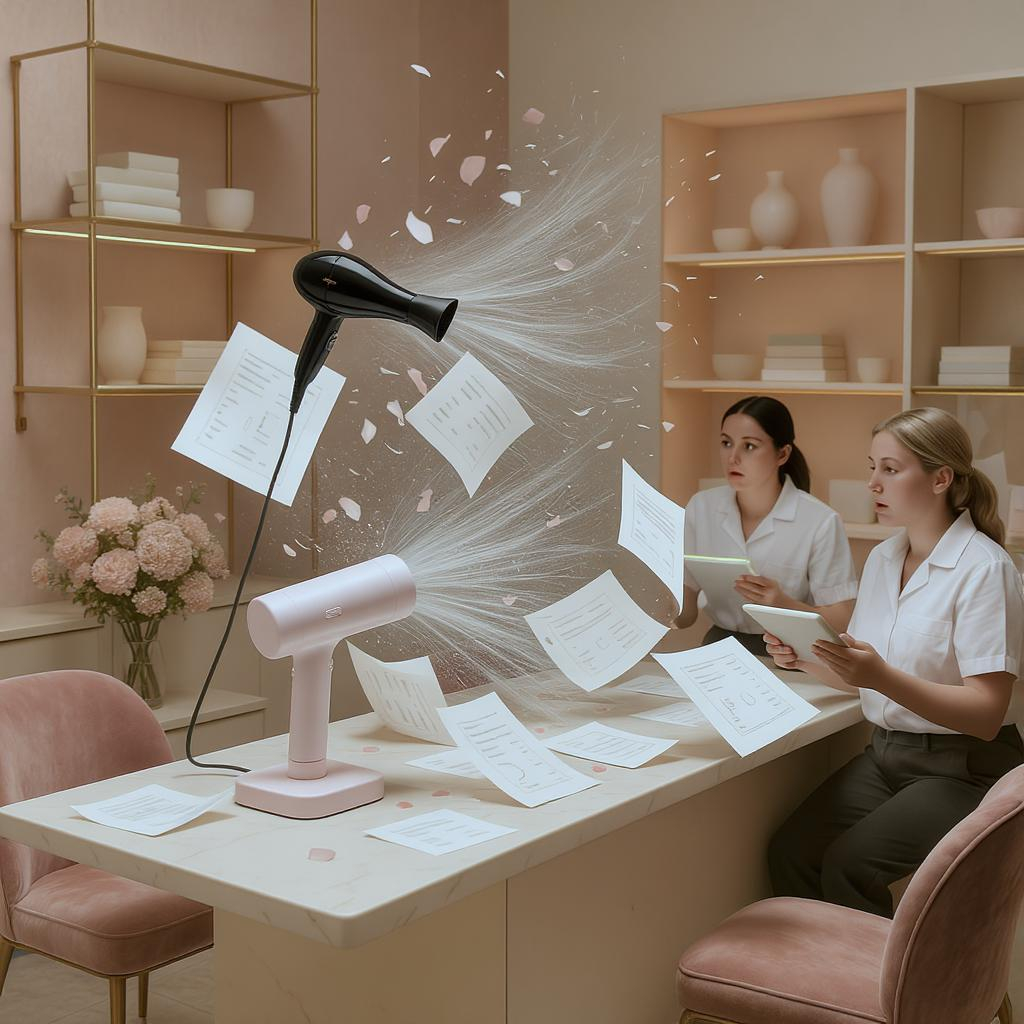Shark had everything they needed to dominate both premium and mass markets through superior strategic market positioning. Instead, they played it safe, stayed in their lane, and handed Dyson the victory they should have stolen. Here’s the billion-dollar strategic market positioning mistake that every ambitious company needs to avoid.
The $600 Million Missed Opportunity
Shark had Dyson on the ropes.
The FlexStyle was selling out. Customers were choosing the $300 alternative over the $600 original. Reviews were confirming what everyone suspected: you could get 90% of Dyson’s results at 50% of the cost.
This was Shark’s moment to deliver the knockout punch.
Instead, they did what most companies do when they find success: they got comfortable. They stayed in their lane. They played it safe.
What Shark Did: Released more budget-friendly versions with traditional hot tools, cementing their position as the “good enough” alternative.
What Shark Should Have Done: Used every complaint about the FlexStyle and every limitation of the Dyson to build a premium version that dominated the #1 spot while keeping their mass-market winner in the #2 position through superior strategic market positioning.
The result? Dyson still owns the prestige market through better market positioning strategy. Shark still plays second fiddle. And a billion-dollar opportunity sits on the table, unclaimed.
The Strategic Market Positioning Setup That Made Victory Inevitable
By 2023, Shark had everything they needed to execute flawless strategic market positioning and own the entire beauty tool market:
Market Intelligence Goldmine:
- Thousands of FlexStyle user reviews highlighting exactly what needed improvement
- Years of Dyson customer complaints about price, ergonomics, and missing features
- Proven demand for both premium performance and accessible pricing
- Brand credibility from FlexStyle’s success
Technical Capabilities:
- Engineering team that had successfully reverse-engineered Dyson’s core technology
- Manufacturing infrastructure to support multiple price points
- Supply chain relationships to source premium materials
- R&D budget justified by FlexStyle’s market success
Strategic Position:
- Established brand presence in beauty (no longer the “vacuum company”)
- Retail relationships and distribution channels
- Customer base eager for the next innovation
- Competitive intelligence on exactly where Dyson was vulnerable
The Market Positioning Map:
- Position #1 (Premium): Dyson Airwrap at $600 – high margins, limited market
- Position #2 (Mass Market): Shark FlexStyle at $300 – volume play, proven demand
- Position #3+ (Budget): Various competitors under $200 – race to the bottom
Shark could have owned positions #1 and #2 through superior market positioning strategy. Instead, they chose to create more options for position #3.
The Customer Complaint Blueprint for Market Domination
Every negative review was a product roadmap. Every Dyson limitation was a competitive opportunity.
FlexStyle User Complaints (The Premium Model Roadmap):
- “Gets too hot compared to Dyson” → Better temperature control system
- “Attachments don’t switch directions like Dyson” → Bi-directional barrel technology
- “Build quality feels cheaper” → Premium materials and construction
- “Shorter barrels don’t work for long hair” → Multiple barrel length options
- “No carrying case” → Luxury presentation and storage solutions
Dyson Customer Pain Points (The Market Opportunity Map):
- “$600 is insane for a hair tool” → Premium positioning at $450-500 still beats Dyson
- “Heavy and awkward to hold” → Better ergonomics and weight distribution
- “Limited attachment options” → Broader ecosystem of styling tools
- “Breaks easily outside warranty” → Superior durability and extended warranty
- “Pretentious brand positioning” → More accessible luxury positioning
The Perfect Storm: Every complaint about the FlexStyle told Shark exactly how to build a premium version. Every complaint about Dyson told them exactly how to beat the market leader.
They had the blueprint for perfection. They chose to ignore it.
The Winning Strategic Market Positioning Strategy Shark Should Have Executed
The Two-Tier Market Domination Plan:
Position #1: Shark FlexStyle Pro ($450-500)
- Superior Temperature Control: Lower heat than Dyson with better damage prevention
- Enhanced Ergonomics: Lighter weight, better balance, more comfortable grip
- Bi-Directional Technology: Switch curl direction without changing attachments
- Extended Attachment Ecosystem: More styling options than Dyson offers
- Premium Materials: Better build quality than original FlexStyle
- Luxury Presentation: Beautiful case and premium unboxing experience
- Market Position: “All the innovation of Dyson, with the improvements they should have made”
Position #2: Shark FlexStyle Original ($300)
- Keep Winning Formula: Maintain the value proposition that made it successful
- Continuous Improvement: Address minor complaints without price increases
- Market Position: “Professional results at accessible prices”
The Competitive Advantage Through Strategic Market Positioning:
- Own both the premium innovation conversation AND the accessible alternative conversation
- Force Dyson to compete on two fronts instead of defending one position
- Capture customers upgrading from FlexStyle to premium AND new customers choosing accessible option
- Build brand authority across the entire market spectrum through superior competitive positioning

What Shark Actually Did (And Why Their Market Positioning Strategy Failed)
Instead of market domination through strategic positioning, Shark chose market confusion.
The Backward Strategy:
- Released multiple budget variations with traditional hot tools
- Stayed in the $200-300 price range instead of moving upmarket
- Competed against budget brands instead of challenging Dyson
- Diluted their brand message with too many similar options
The Strategic Market Positioning Mistakes:
Mistake #1: Comfort Zone Trap They got comfortable being the “good value” alternative instead of becoming the market leader through strategic market positioning.
Mistake #2: Race to the Bottom They competed on price instead of competing on innovation and value through better market positioning.
Mistake #3: Opportunity Cost Blindness They focused on defending their market share instead of expanding their market position through competitive strategy.
Mistake #4: Customer Signal Ignorance They ignored clear customer feedback about what a premium version should include in their market positioning strategy.
The Result:
- Dyson still owns the premium conversation and margins
- Shark still plays second fiddle in the public perception
- Multiple budget competitors now compete in Shark’s space
- The premium market opportunity remains unclaimed
The Business Lesson: Why Poor Strategic Market Positioning Kills Growth
Most companies make Shark’s strategic market positioning mistake. They find success in one segment and assume they should stay there through limited competitive positioning.
The “Lane” Fallacy:
- “We’re the affordable brand” becomes a self-imposed ceiling
- “We don’t compete with premium players” becomes strategic surrender
- “Our customers won’t pay more” becomes market assumption instead of market testing
The Market Reality for Strategic Positioning:
- Customers don’t care about your “lane” – they care about value at every price point
- Premium segments often have higher margins and lower competition
- Brand authority comes from being the best, not just the cheapest
- Market leaders own multiple segments simultaneously through superior market positioning strategy
Why Strategic Market Positioning Matters for Every Business:
- Success in one segment creates opportunities in adjacent segments
- Customer complaints are product roadmaps for premium versions
- Competitor limitations are market opportunities waiting to be captured through better competitive positioning
- “Good enough” positioning limits growth potential
The Opportunity That Still Exists
Here’s the fascinating part: the premium beauty tool market is still wide open.
Current Market Reality:
- Dyson still charges $600+ for incremental improvements
- No competitor has seriously challenged them at the premium level
- Customer complaints about Dyson remain unaddressed
- The FlexStyle proved that alternative brands can gain market acceptance
The Window of Opportunity:
- Customers are educated about the technology and benefits
- Price sensitivity has been established ($300 works, $600 feels excessive)
- Technical barriers have been overcome (Coandã effect is replicable)
- Brand credibility can be built through superior execution
What’s Missing: A brand willing to invest in premium materials, superior engineering, and luxury positioning to take the #1 spot while maintaining their #2 position.
The Strategic Market Positioning Framework: How to Dominate Multiple Market Segments
Step 1: Leverage Success for Market Expansion
- Use current market position to justify premium development
- Reinvest profits from mass market success into premium R&D
- Build on brand credibility to support upmarket positioning through strategic market positioning
Step 2: Customer Intelligence Mining for Competitive Positioning
- Analyze every complaint about your current product
- Study every limitation of the market leader
- Identify the intersection of problems that premium pricing can solve
Step 3: Two-Tier Product Strategy
- Maintain winning formula in current segment
- Develop premium version addressing all identified pain points
- Position both products as serving different customer needs, not competing
Step 4: Market Positioning Warfare
- Challenge market leader on their weaknesses through superior competitive strategy
- Own the conversation about innovation and value
- Force competition to respond on multiple fronts
Step 5: Brand Authority Building Through Strategic Positioning
- Become known for the best solution at every price point
- Own the innovation conversation across market segments
- Build customer loyalty through superior execution
The Competitive Dynamics Most Companies Miss
When you successfully challenge a market leader, you earn the right to replace them—if you’re willing to take the shot.
The Shark Advantage They Squandered:
- Proven technical capability to match Dyson’s core technology
- Established brand presence in the beauty category
- Customer base ready to upgrade to premium version
- Market intelligence on exactly what improvements customers wanted
The Strategic Window They Missed:
- Dyson was focused on defending against price competition, not quality competition
- Premium beauty tool market was underserved and ripe for disruption
- Customer education costs were already paid by Dyson’s marketing
- Technical feasibility was already proven by FlexStyle’s success
The Lesson for Every Ambitious Company: Success in a lower market segment is permission to compete in higher segments through strategic market positioning—if you’re willing to invest in being genuinely better, not just cheaper.

The Billion-Dollar Question for Your Business
While you’re reading about Shark’s missed opportunity, ask yourself: What premium market is your current success creating access to through strategic market positioning?
Every company that finds success in one segment earns the right to compete in adjacent segments. The global beauty tools market is projected to reach $339.90 billion by 2034, growing at 14.2% CAGR. The question is whether you’ll recognize the opportunity or stay comfortable in your current market position.
The Strategic Audit for Market Positioning:
- What complaints do your customers have that premium pricing could solve?
- What limitations does the market leader have that you could address through better competitive positioning?
- What technical capabilities have you developed that could support premium market positioning?
- What brand credibility have you built that could justify higher prices?
The Market Reality Check for Strategic Positioning:
- Are you defending market share or expanding market position through strategic planning?
- Are you competing on price or competing on value through market positioning strategy?
- Are you optimizing for what worked or what could work better through competitive strategy?
- Are you building for comfort or building for market domination?
The Strategic Choice: Every successful company eventually faces Shark’s choice: stay safe in your lane or risk everything to own the entire highway through superior strategic market positioning. The companies that choose safety get to keep their current position. The companies that choose ambition get to define the market through competitive strategy.
The Real Tragedy: It’s Still Not Too Late
Here’s what makes Shark’s strategic mistake so painful: the opportunity window is still open.
Why Shark Could Still Execute This Strategy:
- FlexStyle brand recognition continues to grow
- Dyson hasn’t significantly improved their offering
- Customer complaints about both products remain unaddressed
- No other competitor has attempted a serious premium challenge
The Current Competitive Landscape:
- Dyson: Still overpriced, still heavy, still limited
- Shark: Still budget-positioned, still missing premium opportunity
- Everyone Else: Still competing on price in the budget segment
What This Means: The first company to execute Shark’s missed strategy—whether it’s Shark themselves or a bold new entrant—will own a billion-dollar market that’s sitting wide open.
The Bottom Line: Comfort Zones Don’t Build Empires
Shark had everything they needed to dethrone Dyson and chose comfort over conquest.
They proved they could match the technology. They proved customers would choose their alternative. They proved the market was ready for disruption.
Then they stopped proving anything at all.
The Strategic Reality:
- Market leaders aren’t unbeatable—they’re just uncontested through superior strategic market positioning
- Customer complaints are competitive roadmaps waiting to be followed
- Success in one segment creates opportunities in premium segments through market positioning strategy
- Playing it safe is the most dangerous strategy of all when competitors use better competitive positioning
The Opportunity Cost: While Shark was releasing budget variations, Dyson announced a £500 million ($636 million) beauty expansion with 20 new products by 2026. They’re doubling down on innovation while their closest competitor chose to retreat.
The Universal Business Lesson: Somewhere in your industry, there’s a market leader charging premium prices for products that could be better. There’s a segment of customers complaining about limitations that engineering could solve. There’s an opportunity to dominate multiple market positions instead of defending one through strategic market positioning.
The question isn’t whether these opportunities exist. The question is whether you’re ambitious enough to take them when success creates the chance through superior competitive strategy.
Because comfort zones don’t build empires. Strategic market positioning does.
Shark chose comfort. Dyson kept the crown through superior market positioning strategy. And a billion-dollar lesson in strategic market positioning sits waiting for the next company smart enough to learn from both their successes and their strategic blindness.
Your move.
Want to identify the premium opportunities your current success has created through strategic market positioning? The competitive positioning framework that moves you from market participant to market leader isn’t theoretical—it’s actionable. The only question is whether you’re ready to stop defending your position and start claiming new territory through superior strategic market positioning.




